Nearly every week I read new stories about climate change and its impact on the future of trout fishing. In 60 years – if nothing changes and computer models are correct – it’s predicted that Earth’s climate will have changed so drastically that half of all suitable trout habitat on the planet will disappear.
As if that’s not dire enough, a consensus exists among scientists, sportsmen, and conservation groups that we could reverse the impact of climate change if we simply tried harder.
It’s an unquestionably important message, and a conversation that’s imperative to the future of Earth’s wild places. However, depicting solely doom-and-gloom scenarios, regardless of their reality, shrouds what we could use as a positive motivator to see real, lasting decisions made to combat climate change.
I’m talking about our wonderfully successful efforts to restore wildlife back to their place on the American landscape. From the resurgence of grizzly bears to the resurrection of Lahontan cutthroat, we sportsmen are living in a golden age of wildlife restoration. Amidst the real and present dangers of climate change, we’ve still found a way to cowboy up, spit in the face of overwhelming odds, and claim some major conservation victories.
And now, a fifth of the way through the 21st century, we’re looking at the very real possibility of closing the chapter on one of the most widely-supported wildlife restoration projects ever.
We’re less than two decades away from ending cutthroat trout restoration in Utah.
The end in sight
Back in the 70s, fisheries biologists in Utah were up a creek without a paddle. Bonneville cutthroat, the state fish and most widely-distributed cutthroat subspecies in Utah, were all but extinct.
“We were at a point where we weren’t hardly aware of any Bonneville populations in the state,” Randy Oplinger, Sportfish Coordinator for the UDWR, said. After discoveries of remnant cutthroat populations, though, Oplinger said, “Utah went from knowing we had a few isolated pockets to having 1,430 miles of (restored) Bonneville habitat.”
That may not sound like much, but bear in mind that Utah is the second-driest state in the Union. In addition, much of Utah’s stream and river miles come from the Uinta Mountains, a fairly inaccessible wilderness area that houses hundreds of miles of Colorado River cutthroat habitat. Utah is now up to 857 miles of restored Colorado River cutthroat habitat, per Oplinger.
And according to both Oplinger and Bryan Englebert, a regional sportfish biologist for the UDWR, the 2,287 miles of restored cutthroat habitat means Utah is likely 12-16 years away from the end of active restoration projects.
Let that sink in for a moment. 12-16 years. Less than two decades.
In spite of our current problems, like habitat loss and climate degradation, Utah’s fishery managers are less than two decades away from wrapping up cutthroat restoration.
But what exactly does that mean? And why, exactly, should we celebrate the end of restoration?
Restoration vs. maintenance
Last fall, Bryan Englebert and I were out fishing a tiny creek in eastern Utah. Bryan works in Utah’s Northeast Region, and he’s spent a lot of time on his hands and knees to restore cutthroat habitat. The stream he took me to that day was a source of personal pride for him, and it didn’t take long to see why.
We fished mice all day, to sizeable Colorado River cutthroat. There are few, if any, places in the West where trout are so unpressured that they’ll recklessly smack mouse flies at any given time of the day.
That stream is just one of many that are full to bursting with native cutthroat — a direct result of restoration efforts. Soon enough, though, Bryan’s projects on streams like this will look much different. Instead of heavy equipment and seasonal technicians rerouting streams, planting willows, restoring banks, and improving riparian habitat, these streams will be sampled for fish population estimates.
That shift may not seem monumental, but it’s a big pivot to make within wildlife management. It’s the difference between restoring and maintaining a population of threatened wildlife.
“Restoration means we’re going out and actively getting areas and doing restoration activities, which would mean a direct management action, whether that be nonnative fish removal, fish stocking, or both,” Englebert said. “We’re going out actively seeking large chunks of mileage and streams and such and actively managing for cutthroat trout, meaning we’re doing restoration actions.”

Upon successful completion of restoration projects, biologists enter what Englebert calls maintenance mode.
“A lot of maintenance mode means we’re getting to do more surveys, like what we’ve traditionally been able to do,” Englebert said. “Maintenance mode is really where we’re at a point where we’re not actively seeking out restoration opportunities, other than maintaining. If we have a pure conservation population that becomes invaded, or if we have a major wildfire, then yes, our maintenance mode says let’s go back in there and get that population up and running, but we’re not looking to expand more range anywhere.”
Switching the focus from restoration to maintenance is a bit more significant than putting papers in the “out” tray on your desk at the end of the day. It signifies that we’ve restored habitat and established populations that can survive without us holding their hands. For cutthroat trout, that’s nothing short of miraculous.
Robust populations
A major factor in whether a restoration project is deemed successful lies in how robust a population exists as a result of the project. As both Englebert and Oplinger explained to me, short one-to-two mile restoration projects aren’t effective long-term solutions. Populations of cutthroat trout need to be connected throughout a wide range to ensure adequate genetic diversity and survivability of the species.
“A lot of the work we’re trying to do is create larger stream segments to behave more like they did before we fragmented the landscape,” Oplinger said.
That work includes everything from major projects like rerouting streams, to installing culverts to help fish access prime spawning habitat. On the Weber River, a piece of water in northern Utah, a lot of smaller projects have been completed over the past few years that have connected the drainage’s various cutthroat populations.

The Weber has historically been heavily diverted for agricultural use. That’s still the case today, but thanks to the hard work of Utah biologists and partnerships with other groups, cutthroat can still thrive in the face of water diversions.
“We’ve had a lot of collaboration with [Trout Unlimited], they have a lot of biologists that are passionate about that system,” Oplinger said. “People still divert water, but we’ve been able to work with a lot of partners to make things more fish-friendly.”
Even with Utah’s smaller amount of water, these results are encouraging. They show that, even in a staunchly right-wing community like Utah, various factions of land users are willing to work together for the future health of the land.
Why Utah?
Utah’s success comes in part from the cooperation between state and federal biologists and local landowners, national agencies like Trout Unlimited, and the fewer miles of stream Utah has to restore than neighboring states.
Something both Englebert and Oplinger noted, though, is that Utah is unique in its use and application of rotenone. Rotenone is a chemical used to kill fish, that has negligible impacts on other wildlife and degrades within hours in an aquatic environment. In areas where cutthroat habitat is overrun with brook, brown, or rainbow trout, rotenone is an effective tool in nonnative fish removal.

“Our neighbor states haven’t been able to attack the problem head-on with rotenone, and rotenone is really a vital tool for us to vacate these areas that have invasive fish populations,” Englebert said. “I’ll name Arizona as an example. They actually have a state law that requires approval to actually use rotenone on a project. If we had that policy in Utah, that would make it really difficult to make progress here.”
Rotenone is a misunderstood tool, and one for which the UDWR tries to maintain a high level of transparency.
“It’s a chemical, you have to be honest,” Englebert said. It’s a registered pesticide, it’s being placed in the natural environment, and in some of these treatments we’re placing it in wilderness areas.”
However, rotenone is a natural chemical derived from the roots of bean plants from Brazil. And according to Englebert, the most harmful thing about rotenone when it’s applied in liquid form to treat rivers, is the amount of oil and petroleum products used to dissolved the rotenone.

“The emulsifying agents, they’re much more toxic than any rotenone would be,” Englebert said. “But they’re used because rotenone is otherwise not soluble in water, so that’s why we use those agents. The petroleum distillates typically evaporate really quickly after application. The rotenone, some of it does get bound to sediment, and eventually that rotenone becomes chemically deactivated and broken down into base elements, similar to say your tomato roots in your garden.
“The stuff (rotenone) that’s in the water column is broken down by sunlight, and it’s a much more rapid neutralization process.”
In addition to Utah’s ability to be nimble with rotenone use, Englebert also noted that Utah was one of the first states to draft a cutthroat management plan, back in the late 90s. Utah is a leader in cutthroat restoration largely because the state got a head start on other parts of the West.
The end is near
From connecting fragmented populations to restoring fish back to their native ranges, Utah is just about ready to wrap up major restoration projects. Soon enough I’ll be tagging along on cutthroat sampling trips with the UDWR, as opposed to restoration projects that look like a construction site.
This doesn’t mean cutthroat are fine elsewhere in the West, though. Nor does it mean that we can take a break from protecting what little wilderness we have left. Rather, all of us — anglers, hunters, backpackers, anyone who uses the Western wilderness — can point to cutthroat restoration as proof that our work isn’t in vain, that these projects actually work and are wildly successful.
And it’s important to remember we’re after lasting success—the kind of change that extends across generations of trout anglers. We can and should continue to point to cutthroat restoration as the wonderful success that it is. But decades of hard work, financial investments, and partnerships are a bad winter or two away from ruin if we don’t capitalize on our successes and protect what we’ve achieved from the impacts of human-induced climate change.
I’m excited to see the end. But I’m even more excited to see what we’re able to do next.




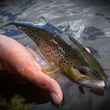
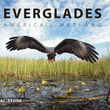

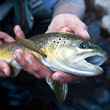








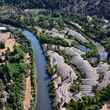



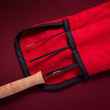

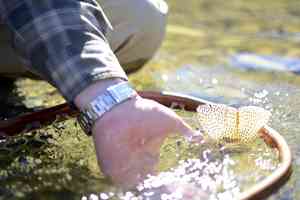
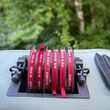


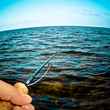

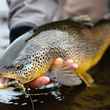
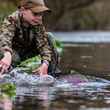
Comments